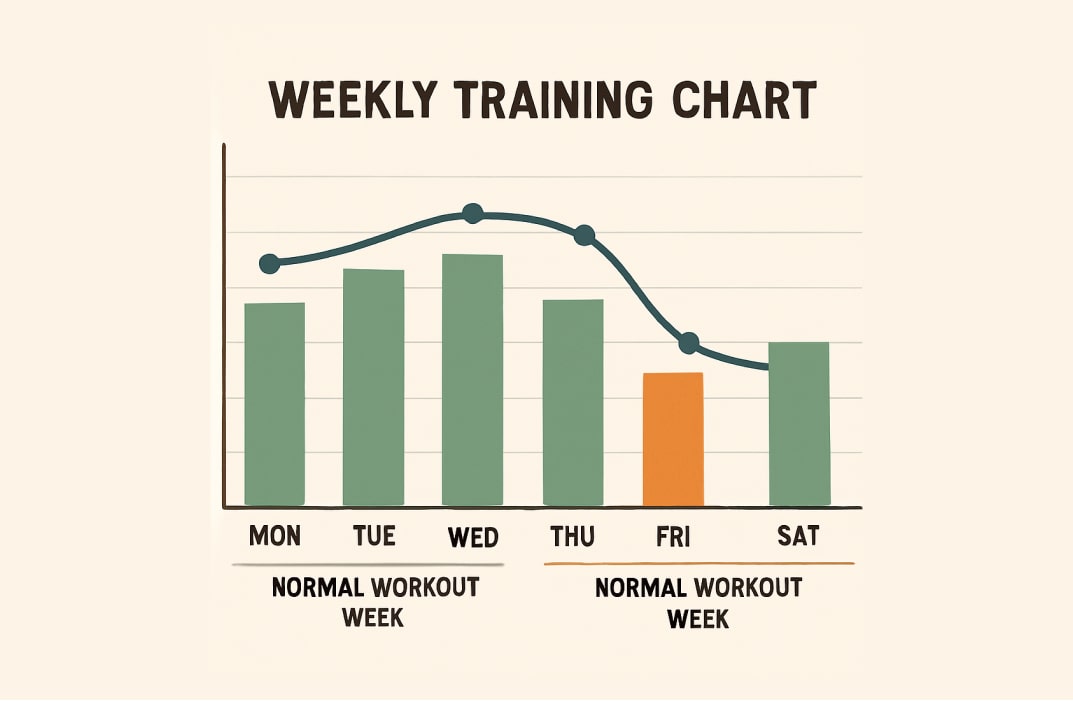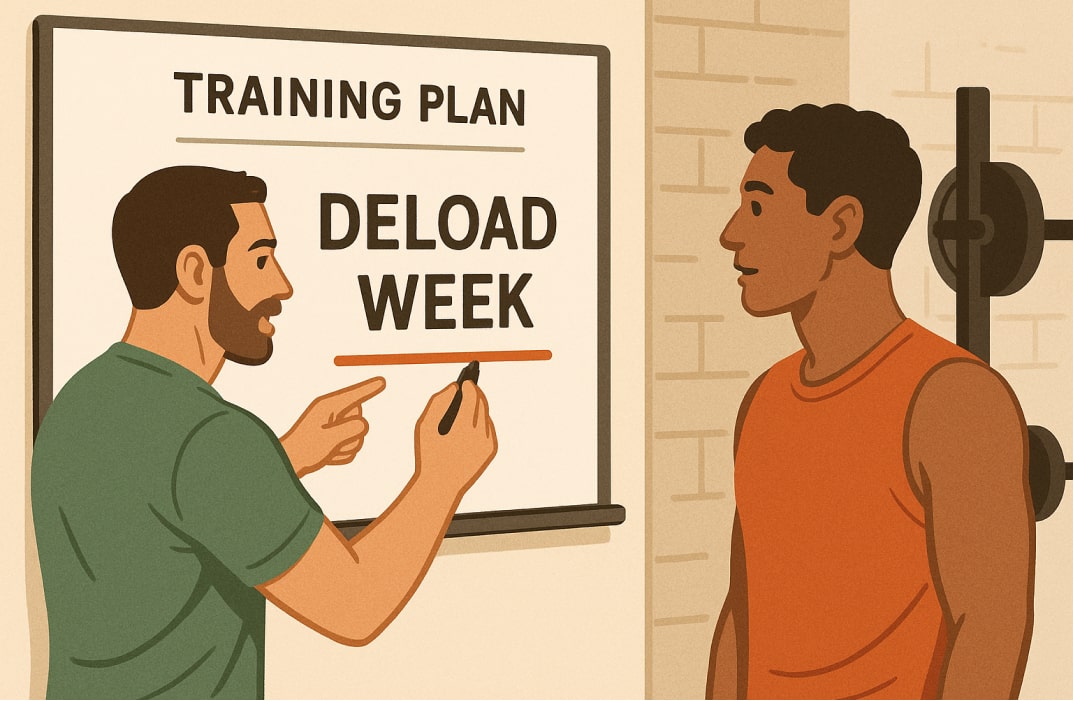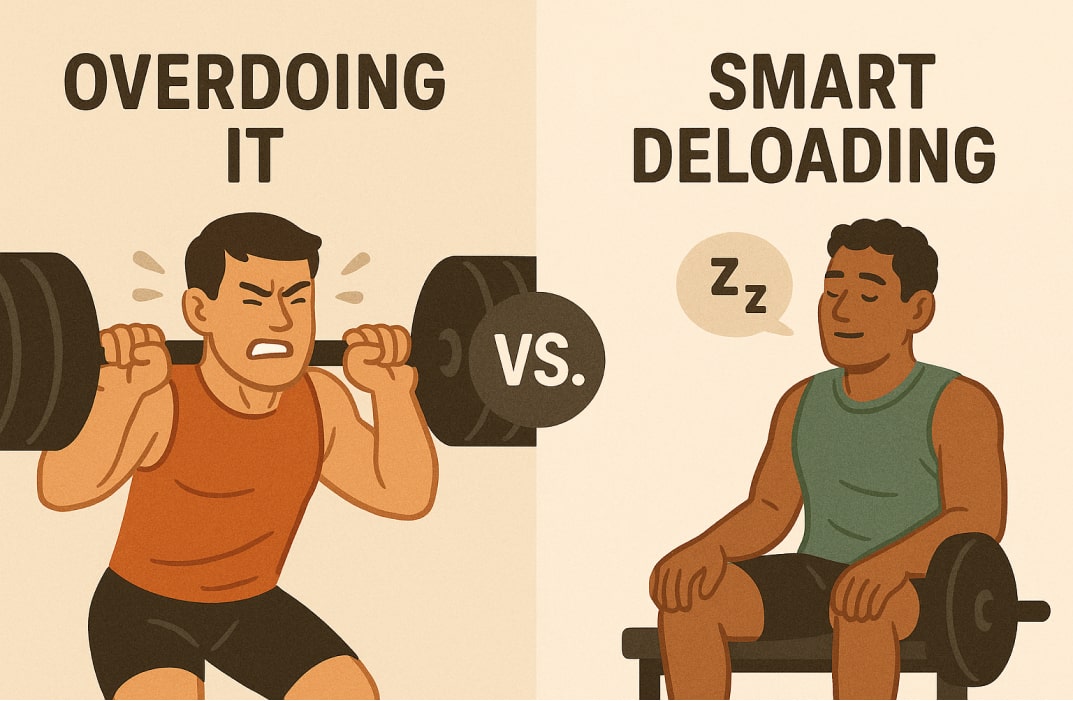Ever notice how even the most dedicated lifters hit a wall after weeks of heavy training?
Studies show that consistent high-intensity workouts without recovery can lead to a 15–25% drop in performance. Hence, you might need a deload week, and significantly increase the risk of overtraining. That’s where a deload week comes in — your secret weapon for long-term progress.
A deload week is a short, strategic break from intense training where you intentionally reduce your workout volume or intensity.
Unlike taking complete rest, deloading helps your body recover while keeping your movement patterns sharp. It allows your muscles, joints, and nervous system to recharge — setting the stage for better strength, endurance, and consistency in the weeks ahead.
Feeling curious to know more, here you’ll learn:-
- What a deload week means
- Why it’s essential for recovery
- How to implement a deload to boost your results without losing momentum.
Why Deload Training Is Important?

Every training session puts stress on your muscles, joints, and nervous system. When you stack weeks of high-intensity workouts and challenging training without proper rest, your body starts to show signs of physical and mental fatigue. This ongoing strain can eventually lead to muscle damage, plateaus, or even overtraining syndrome. It is a common issue that affects nearly 30% of competitive strength athletes at some point in their careers.
A deload week acts as a safety valve. It’s a reduced training stress designed phase where you intentionally lower training intensity and volume to help your body and mind recover. Instead of skipping the gym, you train with lighter weights, fewer reps, and focus on movement quality over load. This controlled deload period promotes recovery, allowing your muscles, tendons, and joints to heal while maintaining your normal training routine.
For instance, a powerlifter who benches 120 kg for 5 reps during normal training might lift around 90–95 kg during a deload week.
That small adjustment can reduce training load by about 20–25%, significantly reducing fatigue while preserving strength.
Over time, these short recovery phases enhance preparedness, improve athletic performance, and ensure better results in the next mesocycle of training.
Signs You Need a Deload
Knowing when to deload is just as important as training hard. Many athletes and lifters push through physiological and psychological fatigue until performance starts to decline. But your body often sends early warning signs that it’s time for a deload week before things get worse.
Common indicators include:
- Persistent muscle soreness: If your muscles stay sore for days after each training session, it may signal excessive training load and muscle damage.
- Decreased performance: Struggling to lift your usual weight or complete your workout routine with the same number of reps is a clear red flag.
- Mental fatigue or loss of motivation: When the thought of going to the gym feels like a chore, your nervous system might need a break.
- Poor recovery or sleep quality: Difficulty sleeping, reduced appetite, or constant fatigue are signs of accumulated stress.
- Lingering joint pain: If your joints and tendons ache more than usual, it’s a cue to reduce volume and intensity for a week.
As a general rule, most strength athletes and recreational lifters benefit from a deload week every 4–8 weeks, depending on training volume, intensity, and recovery ability. However, some competitive athletes who follow higher training schedules may need frequent deloading to sustain performance and fitness gains.
Listening to your body and recognizing these early signs allows you to take a pre-planned deload period—before fatigue turns into injury or burnout.
How to Implement a Deload Week

Implementing a deload week doesn’t mean stopping training altogether. Instead, it’s about reducing training stress while keeping your muscles active and maintaining light exercise for your nervous system. The goal is to promote recovery, prevent overtraining, and enhance preparedness for your subsequent training.
Here are common ways to structure a deload week:
- Reduce Training Volume: Cut down weekly sets by 30–50% while keeping the same exercises. For example, if you usually do 5 sets of bench press, do 3 sets instead.
- Lower Training Intensity: Use lighter weights—typically 50–70% of your normal load—while maintaining proper form and technique.
- Fewer Training Days: Reduce your workout routine from 5–6 days to 3–4 training sessions, giving your muscles, joints, and nervous system extra recovery.
- Focus on Movement Quality: Incorporate mobility exercises, bodyweight movements, or deloading workouts that emphasize control over load.
- Combination Approach: Some athletes reduce both volume and intensity, which is especially effective for strength athletes dealing with muscle damage or psychological fatigue.
Example: A powerlifter doing a normal training session with heavy bench, squat, and deadlift might switch to 3 sets of 8–10 reps at 60% weight, include light accessory work, and skip high-intensity conditioning. This deload period allows muscles, joints, and the nervous system to recover while maintaining muscle hypertrophy and strength gains.
Should Beginners Deload Too?
If you’re new to training, you might wonder — what is a deload week, and do you really need a deload week? The short answer is yes, but not as frequently as advanced athletes.
A deload week is a short period—usually one week—where you intentionally reduce volume, lower intensity, and give your body a chance to recover from challenging training.
For beginners, deloading helps your muscles, joints, and nervous system adapt safely to consistent exercise. Since your training load is typically lighter, you may only need a deload every 8–10 weeks, or whenever you feel persistent soreness, fatigue, or loss of motivation.
During your deloading week, try performing your usual workout routine with lighter weights, fewer reps, or training on fewer days.
For example, if you usually train five days a week, scale it back to three and use about 60–70% of your normal load.
A coach can guide you on how to deload effectively—balancing rest and light deload workouts so your body continues to progress without burnout. In simple terms, deloading isn’t a setback; it’s a smart recovery strategy that builds consistency and long-term growth.
Deload Week Examples
Planning a deload week can be simple, whether you’re a competitive athlete or a recreational lifter. The key is to reduce training stress while keeping your muscles, joints, and nervous system active. Here are a few practical examples:
1. Strength Training Deload for Volume and Intensity
- Frequency: 3–4 training sessions instead of your usual 5–6.
- Intensity: Reduce weight to 60–70% of your usual load.
- Volume: Cut weekly sets by 30–50%.
- Focus: Maintain form, use lighter weights, and avoid pushing to failure.
Example Session:
- Squat: 3 sets × 8 reps at 65%
- Bench Press: 3 sets × 8 reps at 60%
- Deadlift: 2 sets × 6 reps at 65%
- Accessory work (e.g., rows, lunges) with lighter weights
2. General Fitness/Bodybuilding Deload
- Frequency: Reduce your workout routine to 3 days.
- Intensity & Volume: Lower weight and reps, keep exercises the same.
- Focus: Add mobility, stretching, and active recovery.
Example Session:
- Dumbbell Shoulder Press: 3 sets × 10 reps at 50–60% weight
- Lat Pulldown: 3 sets × 12 reps at 50% weight
- Bodyweight Squats or Goblet Squats: 3 sets × 12–15 reps
- Core exercises and light cardio
Tips for All Athletes
- Keep deload weeks pre-planned in your training schedule.
- Avoid intense workouts; the goal is to reduce fatigue and promote recovery.
- Listen to your body: if physical fatigue or muscle soreness persists, consider adjusting volume and intensity further.
A well-structured deload week ensures that muscles, joints, and the nervous system fully recover, setting you up for enhanced performance and fitness gains in your subsequent training.
Common Mistakes During Deload Weeks

Even though a deload week is meant to reduce fatigue and promote recovery, many athletes and strength sports enthusiasts make mistakes that limit its effectiveness. Recognizing these pitfalls can help you maximize fitness gains and return stronger for subsequent training.
1. Skipping Workouts Completely
Some think a deload means taking a full week off. While rest is important, deload training is designed to reduce training stress—not eliminate movement. Lower training intensity with lighter weights and fewer weekly sets helps your muscles, joints, and nervous system recover without losing strength gains.
2. Maintaining Normal Training Load
Continuing high-intensity workouts or your normal training volume defeats the purpose of a deload week. Without lowering training intensity or volume, physical fatigue, muscle soreness, and psychological fatigue can worsen, increasing the risk of overtraining syndrome.
3. Ignoring Recovery Outside the Gym
A deload period isn’t just about the workout routine—it’s also about recovery. Skipping sleep, proper nutrition, or hydration can prevent muscle repair and nervous system recovery, reducing the benefits of lighter training sessions.
4. Jumping Back Too Quickly
Returning to heavy weights or high-intensity training immediately after a deload week can shock your muscles and joints. Gradually increasing training load ensures your body adapts and your performance improves for the next mesocycle.
By avoiding these common mistakes, your deload week can effectively mitigate physiological and psychological fatigue, maintain progress, and prepare you for intense workouts in the weeks ahead.
Read more: Science Behind High-Intensity Interval Training (HIIT)
Different Deload Strategies for Endurance vs. Strength Athletes
Not all deload weeks look the same. The way you reduce volume and intensity depends on your sport, training schedule, and recovery needs. A strength athlete and an endurance athlete both need a deload week, but how they approach deloading is very different.
For strength athletes, a deload week focuses on lowering training intensity while keeping exercise selection and movement patterns the same.
For example, if you’re used to lifting heavy weights for 5 sets of 5 reps, switch to 3 sets at 60–70% of your normal load. This keeps your body moving without adding excessive training stress. It’s an active break that supports muscle repair and maintains strength.
Endurance athletes, on the other hand, focus on lowering training volume — cutting total mileage, reducing workout frequency, or training on fewer days during a deloading week. This approach gives the nervous system and joints time to recover from repetitive movement patterns.
How Often Should You Deload?
Determining when to deload depends on your training schedule, workout intensity, and recovery needs. Both competitive athletes and recreational lifters benefit from pre-planned deload weeks, but the frequency can vary based on training load, volume, and intensity, and overall physical fatigue.
General Guidelines
- Most strength athletes should include a deload week every 4–8 weeks of high-intensity training.
- Those doing frequent, intense workouts or following heavy weight programs may need more frequent deloading to mitigate physiological and psychological fatigue.
- Recreational athletes can schedule deload weeks less often, especially if their training volume and intensity are moderate.
Factors Affecting Frequency
- Training volume and intensity: Higher weekly sets, heavier weights, and more training sessions increase the need for a deload period.
- Physical and mental fatigue: Persistent muscle soreness, joint discomfort, or mental fatigue signals a need to deload sooner.
- Upcoming competitions or performance goals: Competitive strength athletes may plan deload weeks strategically before events to enhance preparedness.
Tip: Track your training load, recovery, and performance metrics. Adjust the deload frequency based on how your body responds, ensuring steady progress and sustained fitness gains in the long run.
Benefits of a Well-Planned Deload Week
A properly executed deload week offers multiple advantages for athletes, strength athletes, and recreational lifters alike. By incorporating lower body strength exercises, lower training intensity, reduced training stress, and lighter weights, you allow your body and nervous system to recover while maintaining your workout routine.
1. Reduce Physical and Psychological Fatigue
Continuous high-intensity workouts and heavy weights can lead to muscle soreness, muscle damage, and psychological fatigue. A deload period helps mitigate physiological and psychological fatigue, allowing joints to recover and muscles to repair.
2. Promote Recovery and Prevent Injury
By lowering training volume and intensity, starting from a pre deload starting point a deload week gives your tendons, joints, and muscles the chance to repair. This reduces the risk of overtraining syndrome and injury, especially for strength athletes following heavy weight programs or frequent deloading cycles.
3. Maintain or Enhance Performance
A well-planned deload allows your nervous system to recover and your muscles to adapt. Studies show athletes returning from a deload week can see 5–10% improvements in strength, power, and athletic performance in subsequent training sessions or next mesocycles.
4. Support Long-Term Fitness Gains
For those focused on strength training, muscle hypertrophy, or fitness gains, deload weeks prevent plateaus. By reducing training load without stopping exercise completely, you maintain progress while preparing your body for heavier weights and intense workouts in the following weeks.
In short, a deload week isn’t a break from progress—it’s a strategic tool that ensures sustainable performance, reduces fatigue, and enhances preparedness for subsequent training.
Deload vs Rest Week: What’s the Difference?
Many athletes and recreational lifters confuse a deload week with a simple rest week, but they serve different purposes in your training schedule.
While both reduce training stress, a deload period is pre-planned and designed to maintain muscle activity and nervous system engagement, whereas a rest week often involves complete inactivity.
Deload Week
- Focus: Reduce training intensity and volume while keeping muscles active.
- Purpose: Mitigate physiological and psychological fatigue, maintain strength, and promote recovery.
- Duration: Typically lasts an entire week with lighter weights, fewer weekly sets, or reduced training sessions.
- Benefit: Enhances preparedness for subsequent training and next mesocycle without losing progress.
Rest Week
- Focus: Minimal or no training sessions; complete break from intense workouts.
- Purpose: Allow full recovery from accumulated physical fatigue or injury.
- Duration: Varies depending on athlete's needs.
- Benefit: Helps joints recover and prevents overtraining, but may not maintain muscle activity as effectively as a deload week.
In short, a deload week is a strategic pause in your workout routine, while a rest week is a more passive break. Understanding this difference helps you schedule pre-planned deloading to maximize fitness gains, reduce fatigue, and maintain consistent performance over the long run.
How FitBudd Can Help Trainers Plan and Track Deload Weeks
Planning a deload week for multiple clients can be challenging, especially when balancing training intensity, volume, and recovery needs. FitBudd simplifies this process by allowing trainers to design, monitor, and adjust deload training directly in a single platform.
With FitBudd, trainers can:
- Schedule pre-planned deload periods for each client based on training load, weekly sets, and muscle recovery.
- Adjust intensity and volume dynamically, ensuring muscles, joints, and the nervous system recover while maintaining strength gains.
- Track fatigue and progress using performance metrics, helping prevent overtraining syndrome and manage physiological and psychological fatigue.
- Customize workouts with lighter weights, fewer reps, or reduced training sessions, providing a structured deload week tailored to both competitive athletes and recreational lifters.
- Monitor adherence and recovery, ensuring clients return stronger for subsequent training or next mesocycle, optimizing athletic performance and long-term fitness gains.
By using FitBudd, trainers can confidently implement deload weeks that enhance preparedness, reduce fatigue, and maintain consistent progress in their clients’ workout routines.
Conclusion
.jpg)
A well-planned deload week is an essential tool for anyone serious about strength training, muscle hypertrophy, or long-term fitness gains. By reducing training volume and intensity for an entire week, you give your muscles, joints, and nervous system time to recover, mitigate physiological and psychological fatigue, and prevent overtraining syndrome.
Whether you’re a competitive athlete or a recreational lifter, strategically incorporating deload periods into your training schedule over the next few weeks ensures steady progress, reduces muscle soreness, and prepares your body for subsequent training or next mesocycles.
Remember, frequent deloading isn’t a setback—it’s a pre-planned, recovery-focused strategy that helps you lift heavier weights, maintain performance, and achieve long-term fitness gains. Listen to your body, follow a structured deload workout, and embrace this strategic pause for optimal athletic performance.
92% trainers worldwide gave us 5 stars
Talk to your dedicated success manager and launch your branded fitness app during the demo in minutes.
Start your paid subscription for $79 FREE





%20to%20Become%20a%20Certified%20Personal%20Trainer-min.jpg)





